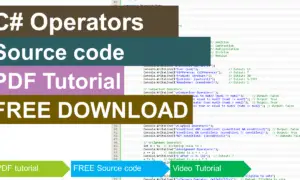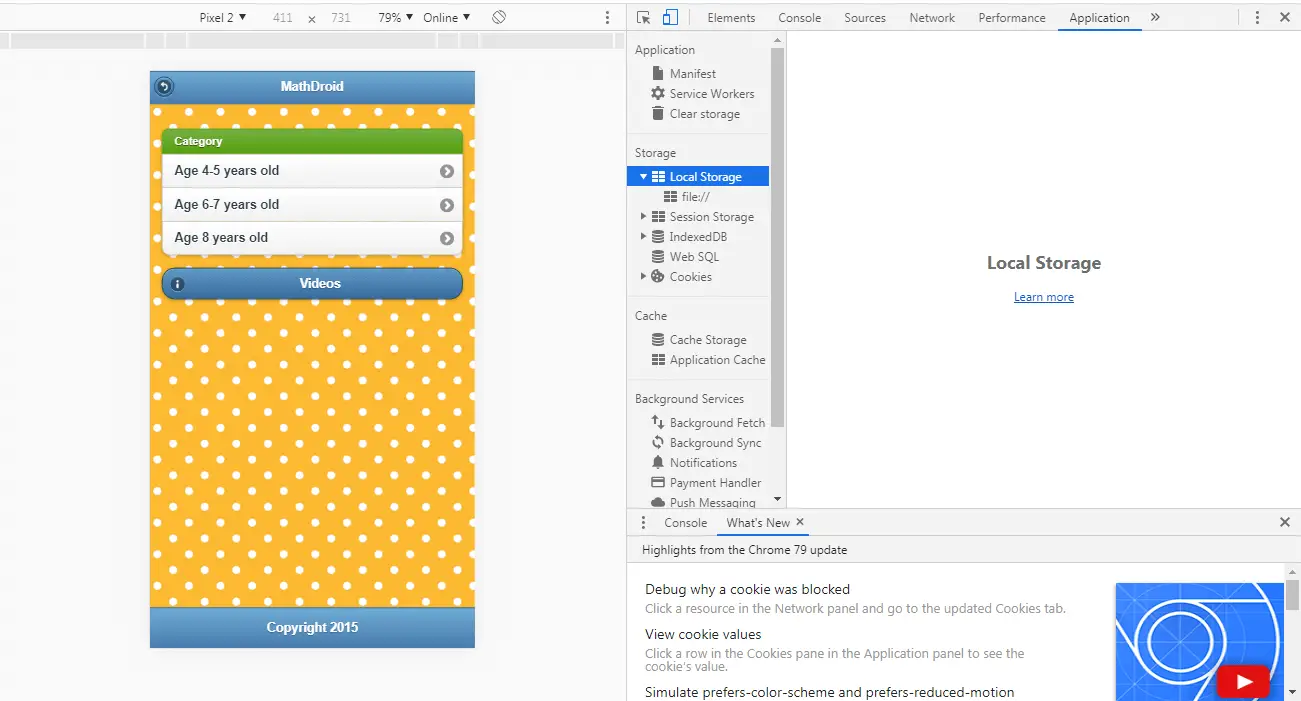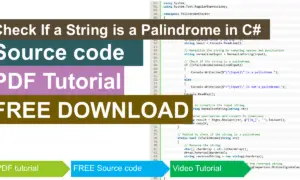Greatest Common Divisor (GCD) Calculator in CSharp
Welcome to an enlightening journey into the world of C# programming, where we unravel the significance of finding the Greatest Common Divisor (GCD) and Least Common Multiple (LCM) of numbers. In this lesson, we embark on the creation of a purposeful C# program designed to calculate the GCD and LCM using the renowned Euclidean algorithm.
Purpose of the Program: The primary aim of our program is to provide a versatile tool for calculating the GCD and LCM of two numbers. Understanding these mathematical concepts is crucial in various fields, from optimizing algorithms in computer science to simplifying fractions in mathematics.
Discover the profound importance of GCD and LCM in both mathematical atinnd programming contexts. GCD represents the largest number that divides two integers without leaving a remainder, while LCM signifies the smallest multiple that is divisible by two numbers. These concepts are foundational in diverse applications, making them essential knowledge for any programmer.
Throughout this lesson, you will delve into the implementation of a C# program that utilizes the Euclidean algorithm to calculate GCD and LCM. This algorithm, renowned for its efficiency, showcases the synergy between mathematical principles and programming logic. By the end, you’ll not only have a functional GCD and LCM calculator but also a deeper understanding of algorithmic calculations in C#.
Let’s embark on this exploration, where mathematical concepts come to life through the art of programming!
Objectives
In this lesson, we aim to unfold the intricacies of finding the Greatest Common Divisor (GCD) and Least Common Multiple (LCM) through the lens of C# programming. Our objectives encompass not only understanding the core principles but also learning to implement a robust algorithm, practicing coding skills, and applying the acquired knowledge to real-world scenarios.
Objective-Based Education (OBE) Focus:
- Understand GCD and LCM Significance (Duration: 20 mins)
- Outcome: Develop a deep understanding of why GCD and LCM are pivotal in various disciplines.
- Indicator: Engage in discussions highlighting the practical applications of GCD and LCM.
- Learn Euclidean Algorithm (Duration: 30 mins)
- Outcome: Grasp the intricacies of the Euclidean algorithm for GCD calculation.
- Indicator: Study examples and walkthroughs to solidify conceptual understanding.
- Practice C# Programming (Duration: 40 mins)
- Outcome: Acquire hands-on experience in C# programming by implementing the GCD and LCM calculator.
- Indicator: Engage in coding exercises that reinforce syntax, logic, and algorithmic thinking.
- Apply GCD and LCM in Programming Contexts (Duration: 25 mins)
- Outcome: Apply the GCD and LCM knowledge to solve programming challenges and optimize algorithms.
- Indicator: Implement GCD and LCM in a variety of scenarios, showcasing real-world applicability.
These four Objective-Based Education (OBE) objectives guide our learning journey, ensuring a holistic understanding of GCD, LCM, and their implementation in C# programming. Let’s dive in and uncover the seamless fusion of mathematics and code!
Source code example
using System;
namespace GCDandLCMCalculator
{
class Program
{
static void Main()
{
Console.WriteLine("iNetTutor.com - Calculate GCD and LCM using the Euclidean algorithm");
Console.Write("Enter the first number: ");
int num1 = int.Parse(Console.ReadLine());
Console.Write("Enter the second number: ");
int num2 = int.Parse(Console.ReadLine());
// Calculate GCD and LCM using the Euclidean algorithm
int a = num1, b = num2;
while (b != 0)
{
int temp = b;
b = a % b;
a = temp;
}
// Calculate LCM
int gcd = a;
int lcm = (num1 * num2) / gcd;
// Display results
Console.WriteLine($"GCD: {gcd}");
Console.WriteLine($"LCM: {lcm}");
Console.WriteLine("Press any key in the keyboard to close the console.");
Console.ReadKey();
}
}
}
Explanation
The provided source code is a C# program that calculates the greatest common divisor (GCD) and least common multiple (LCM) of two numbers using the Euclidean algorithm. Let’s break down the code and explain its functionality:
- The program starts with the necessary using statement to include the System namespace, which provides access to the Console class for input and output operations.
- The program is defined within the GCDandLCMCalculator namespace.
- The program class is defined as Program.
- The Main method is the entry point of the program, where the execution begins.
- The program displays a welcome message and prompts the user to enter the first number using the Console.WriteLine and Console.Write statements.
- The user’s input for the first number is read using the Console.ReadLine method and stored in the variable num1 after parsing it as an integer using int.Parse.
- Similarly, the program prompts the user to enter the second number and reads the input, storing it in the variable num2.
- The program then proceeds to calculate the GCD and LCM using the Euclidean algorithm.
- Two variables, a and b, are initialized with the values of num1 and num2, respectively.
- The while loop is used to repeatedly calculate the remainder of a divided by b until b becomes zero. This is done by assigning the value of b to a temporary variable, updating b to the remainder of a divided by b, and assigning the temporary variable to a. This process continues until b becomes zero, at which point the loop terminates.
- After the loop, the GCD is stored in the variable gcd, which holds the value of a.
- The LCM is calculated by multiplying num1 and num2 and dividing the result by the GCD.
- Finally, the program displays the calculated GCD and LCM using the Console.WriteLine statement, along with a message to close the console.
- The Console.ReadKey method is used to wait for any key press before closing the console window.
In summary, this program takes two numbers as input from the user, calculates their GCD and LCM using the Euclidean algorithm, and displays the results.
Output

Summary
In our blog post, we’ll start by explaining why GCD and LCM are valuable tools for programmers. We’ll break down the Euclidean algorithm step-by-step, so you can understand how it works and why it’s so useful for finding GCD.
Our goal is to help you learn and practice C# programming. We’ll provide coding exercises to give you hands-on experience and help you apply what you’ve learned in real-life situations.
Come join us on this exciting journey where math and programming combine. Whether you’re an experienced developer looking to optimize algorithms or a beginner excited to explore the connection between logic and numbers, our GCD and LCM Calculator program in C# will open up a world of possibilities. Happy coding!
Exercises and Assessment
Exercises to Improve GCD and LCM Calculator Source Code:
- Modularization and Methods:
- Exercise: Refactor the source code by introducing separate methods for GCD and LCM calculations.
- Objective: Enhance code organization and promote modularity for better maintainability.
- User-Friendly Input Handling:
- Exercise: Implement more robust user input handling, including validation for non-numeric entries and negative numbers.
- Objective: Improve the user experience and add error resilience.
- Optimize Algorithm for Larger Numbers:
- Exercise: Enhance the algorithm to handle larger numbers efficiently.
- Objective: Explore optimizations for scalability and performance.
- Additional Mathematical Operations:
- Exercise: Extend the program to include additional mathematical operations such as finding prime factors or calculating the power of a number.
- Objective: Expand the functionality and application scope of the calculator.
These exercises and assessments are designed to elevate the GCD and LCM Calculator project by focusing on code refinement, user experience, and the application of advanced programming concepts. They encourage a comprehensive understanding of C# programming through practical application and continuous improvement.
Related Topics and Articles:
C# While Loop Statement Video Tutorial and Source code
Calculate Average of Numbers in CSharp
You may visit our Facebook page for more information, inquiries, and comments. Please subscribe also to our YouTube Channel to receive free capstone projects resources and computer programming tutorials.
Hire our team to do the project.


